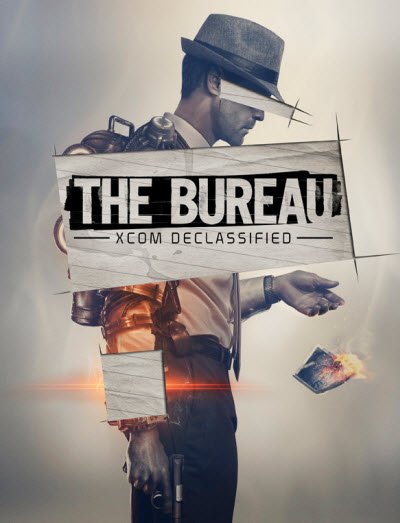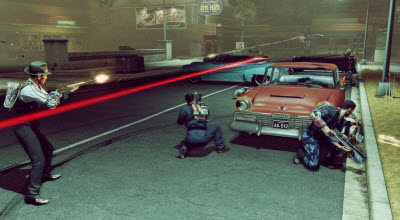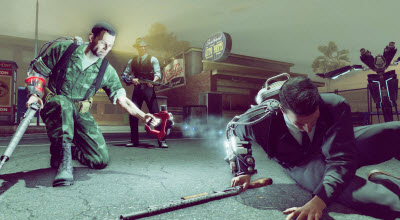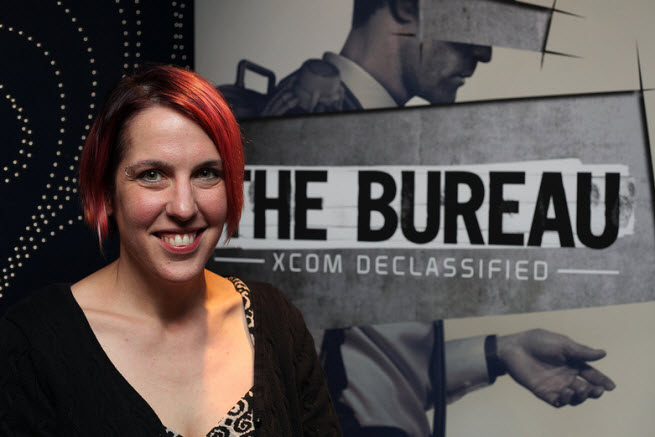Alyssa Finley acknowledges that gamers have had to wait a long time for The Bureau: XCOM Declassified. But the vice president of product development at 2K Marin says it will be worth it. It’s been in the works for years, and Take-Two Interactive‘s 2K Games division finally announced last month that it would arrive in stores on Aug. 23 on the PC, Xbox 360, and PlayStation 3.
2K Games showed off the game in June 2010 at the E3 trade show. At that time, it was a first-person shooter. Now it is a third-person shooter with strong squad combat elements. At any time in the action, you will have two squadmates fighting alongside you and taking your orders during the battle in real time. We recently saw a preview of one level of the game, where you play a federal agent who has to fight a clandestine war against aliens who invade the U.S. in the spring of 1962.
The Bureau’s setting, art work, and game style have all changed. It shows that a lot has been happening at 2K Marin, the maker of BioShock 2, in the past few years. We talked with Finley about the team’s design decisions and what the heart of the game is about. Here’s an edited version of our interview.

GamesBeat: How long have you been working on this?
Alyssa Finley: We announced the game back in 2010 at E3. We’ve been trying to iterate on the core ideas that we’ve shown ever since. You can see that there’s been a real evolution of the first-person shooter that we showed back then. We felt like the thing that an XCOM game really needed was the ability to use tactics, tools, and the team. We’ve been trying to bring the team aspect more and more every time we show the game.
GamesBeat: I only remember so much of what I played then, but yeah, it was more first-person shootery.
Finley: Yeah, exactly. It was a very investigative game. It hit a lot of the XCOM beats, but the one that it didn’t get was that notion of the interplay between you and your team. When you play XCOM, that’s a key part of the experience.
GamesBeat: What you’ve wound up with reminds me a lot of Mass Effect, the style that they have with the two companions and the wheel for commands.
Finley: Absolutely. It’s a great game. You see a lot of inspiration. We’re trying to provide the kind of narrative hub that you see in Mass Effect with our base, where you can go talk to people and see the progression of the war from the home front’s point of view. Also, from a gameplay perspective, you’re right. You have the command wheel where you can get a sense of everyone’s powers. The thing that we’re trying to push on is that notion of being the commander of your team and building fairly complicated plans that you can actually queue up and execute in the field, using those kinds of small team tactics. You really coordinate between the three of you.
GamesBeat: What do you notice about somebody who’s trying it out for the first time? I felt like I kept sending the two guys to the same place to do the same thing. I think I must not have noticed another way to separate them and send them off in different directions.
Finley: There are two different ways to control your team. There are the quick orders, which let you set a placement for both of your guys at once, and then there’s also battle focus, where you can select each guy on your team individually, choose a move order, and basically drive that pointer around to where you want him to go on the field. That lets you set up flanks, or you can take different positions and get very precise control of your guys. When you move them that way, they stay where you tell them to unless they’ve got a grenade in their face or something. They’ll try to execute the orders that you give them. Each of the agents is good by themselves – they have decent AI – but coordinating them as a team yourself is what takes it to the experience we’re looking for.
GamesBeat: The laser turret — that seemed very powerful. It’s good to either put it in front of the enemy, to hold their attention, or to just set it up behind them.
Finley: If you can get close enough. Each ability has a range, so you have to get a position on the battlefield that allows you to get behind their lines. If you can, it’s a huge advantage, but you can’t always do that.
 GamesBeat: It also felt a bit like Brothers in Arms, with so much flanking going on. Except that game used a lot more soldiers. Is there a reason you have just two squad members?
GamesBeat: It also felt a bit like Brothers in Arms, with so much flanking going on. Except that game used a lot more soldiers. Is there a reason you have just two squad members?
Finley: A lot of it is to make you feel a connection to those guys on the battlefield. As you pointed out, that wheel can be tricky, especially if you don’t come in from the beginning of the game and learn to maneuver. We want the player to be balancing between enough power in the field to use small squad maneuvers, but without so many powers that it’s confusing to be out there. If you had six guys and you were trying to control them all in real-time, to keep track of them all in your head, that would be overwhelming. It’s one of the reasons that the isometric view in Enemy Unknown works so well. You can look at six guys – one over here, one up there – and thinking about their placement in relation to the enemies. In a realtime game where you’re tracking all that as it happens, that’s a lot of data.
GamesBeat: Do you draw from the last XCOM game as well? What have you been able to borrow from Enemy Unknown?
Finley: You can see some of those same UI elements. The blue shields and the red shields to show you when you’re in dangerous cover. We’ve tried to add to that as well. We’ve added the little ribbon so that you can not only see that a piece of cover is dangerous, but who is endangering it, so you can make plans around that. I would say that in general we take a lot of inspiration from Enemy Unknown. The one key difference between our games that there, you’re kind of like the coach of the team. You’re the commander sitting up there above everybody and you tell everyone exactly what to do, but you don’t really participate yourself. What we were trying to add to the XCOM experience was that feeling of having your stake in the battlefield as well. You have to plan for your team and be the field commander responsible for these two other guys, and you have some bullets in the game yourself. You can bring your own tactics and your own skill to the party.
 GamesBeat: The art style does look different compared to what I remember from a couple of years ago. How did you change that?
GamesBeat: The art style does look different compared to what I remember from a couple of years ago. How did you change that?
Finley: In 2010, we were very Norman Rockwell-inspired. At that point the game was still set back in the ‘50s. We were trying to get that whole “2.5 kids, a dog, and a car in the driveway” vibe, that family Americana vibe. When we moved the setting to the ‘60s, we wanted to start playing more into the paranoia and the edginess of the Cold War era, where the government could be engaged in covering up incidents in small towns, because America must never know what almost happened to them. In order to keep up the façade of America being this strong country in the face of whatever’s happening—We certainly didn’t want to let the U.S.S.R. know what was going on, because that might give those guys the inspiration to come in and invade themselves, if they knew we were already weakened. So giving us that ‘60s setting turned the art style toward a bit more of a realistic vibe than the Norman Rockwell style. We were able to play with a different set of ideas and try to bring them to life.
GamesBeat: It has a lot of color. I seem to recall less color in the earlier demos. The aliens here seem more colorful, in an almost cartoonish way. How did you change that?
Finley: With the aliens, we take a lot of inspiration from Enemy Unknown and classic XCOM. The Muton wears his purple and green proudly. [laughs] We don’t want to take that away from him. As far as the overall architecture, you’re right. We had more muted colors going on in the Americana, Norman Rockwell style. There’s a ‘60s style of architecture called Googie. It’s things like the space-age-looking diner signs you see from that period — neon signs with big and bold outlines. It’s very colorful, and we think it really says “’60s.” We pulled a lot of inspiration from that in the way the palette works in general.
GamesBeat: What inspired that change in the first place? Was that a sort of pivot in some sense? To me it looks dramatically different, but I don’t know if that was a steady evolution for you guys, or if you went to a pretty far point and then threw it away to start over.
Finley: When you’re in it, it always feels like an evolution. I totally understand from your point of view, because we’ve only showed the game a couple of times. The biggest guiding light we’ve had has been, “How do we make this game feel more XCOM?” I think we hit that vibe in 2010 with things like the base and the notion of research. There were a lot of ideas there that were very XCOM. But we didn’t have a full XCOM experience. We’ve been trying to bring those ideas into the field as well.
That’s been the biggest driver of every change that we’ve made. How do we live up to the promise of this franchise? It’s a franchise that people are passionate about. They have strong beliefs about what it ought to be. Our biggest goal is to make a game that lives up to that, but opens it up to folks who maybe, for whatever reason, don’t like turn-based games. Or maybe they don’t think they like turn-based games. If we open up the XCOM franchise to those guys, maybe the experience they have in our game will lead them to take another look and check out the more classic versions.
 GamesBeat: You guys came from BioShock 2. Do you have some heritage that came from that as well?
GamesBeat: You guys came from BioShock 2. Do you have some heritage that came from that as well?
Finley: The big thing that’s a sort of through-line for 2K Marin is a strong belief that weaving a narrative alongside the gameplay is a really good way to tell a story. That’s why we went to the origin story and tried to make sure that—XCOM isn’t a game known for its story. “Look! There’s a global war! Aliens! Stop them!” That’s awesome. It makes for a great game. But we wanted to say, “What’s an interesting take on this universe that hasn’t been explored before?” So the narrative is one key thing for us.
The other is the notion of player customization and choice. In BioShock 2 we wanted to make sure that folks had the chance to play the game in a way that made them happy, in a way that made them feel like they customized it. For me, as a BioShock player, I like to have bees. I like to be a very passive player, sitting in the corner and letting my plasmids do all the work for me. I think it’s not a coincidence that I’m a big fan of the Engineer in XCOM. Placing those mines and those turrets works the flanks for me. I can work with my team and have a really good sense of a local battle, but use tools to help out on the edges without taking as much risk. I can play how I choose to play.

